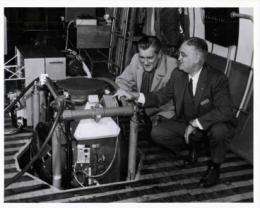Doc Draper in space

On May 25, 1961, President John F. Kennedy laid out a vision for "landing a man on the moon and returning him safely to Earth." Six months later, Charles Stark Draper responded to that call, volunteering his services as an Apollo crewmember.
In a letter to NASA Associate Director Robert Seamans, Jr. — his former graduate student — "Doc," as Draper was affectionately known, wrote:
I realize that my age of 60 years is a negative factor in considering my request, but … I will gladly undergo any physical examinations and tests that may be prescribed and will take any courses of training that may be recommended.
Needless to say, Seamans respectfully declined the request, and Draper, who was then building the navigational system for the Apollo spacecraft, never physically went to space. However, the letter reflects the extraordinary lengths to which Draper often went in championing his technologies.
Now, in recognition of his many innovations in space navigation, Draper's letter has joined the Space Shuttle Endeavour crew on that craft's last mission into space.
As with many aerospace projects, launching the letter on the space shuttle was a multidisciplinary pursuit. MIT's astronaut alumni frequently turn to the Department of Aeronautics and Astronautics for mementos to take into space, including department hats and T-shirts. For Endeavour's last mission, astronaut Greg Chamitoff PhD '92 was looking for something more. Bill Litant, the department's communications director, found the answer while sifting through an old filing cabinet.
"It was just fortuitous that I found the letter, because I was poking through some files, actually looking for other material from that era," Litant says. The letter was faded in places, but it just so happened that another copy existed at the MIT Museum. Litant scanned the best of both copies, and added a picture of Draper before sending the letter off with Chamitoff. "I figure if I'm going to send him into space, he has to be there."
A man and his machines
"This document reminds us of the enormous contributions made by Charles Stark Draper to the American space program," says Debbie Douglas, curator of science and technology at the MIT Museum. "The story of this letter really is part of the larger story of [Draper's] approach to technology."
Draper, who founded the MIT Instrumentation Laboratory — now the Charles Stark Draper Laboratory, Inc. — was known for his larger-than-life persona, depicted frequently in cartoons drawn by the lab's illustrators. He was also famous for his intense attachment to his inventions, often putting himself at risk while testing new systems or proving a technical point.
In the early 1930s, Draper, not yet a full professor at MIT, passed a civilian flying course, then bought himself an airplane. He quickly identified a potential project: Aviation controls of the day were sorely in need of upgrading. To make his case, he took Jay Stratton, a physics professor who later became president of MIT, up for a test ride, dipping and stalling the plane over Boston's Outer Harbor to demonstrate the instruments' shortcomings. Stratton was duly convinced — and also vowed never to fly with Draper again.
Draper's intense faith in his technologies carried over into his most famous work in inertial navigation, a field he founded during his time at MIT. Using gyroscopes and accelerometers, inertial navigation enables aircraft, ships, submarines and guided missiles to find their targets without human intervention.
Draper's inertial navigation work was classified at the time, but in the late 1950s, the Air Force permitted him to make a public announcement — and in 1958, he was accompanied by CBS News journalist Eric Sevareid in a nationally televised flight across the United States in a B-29 equipped with Draper's navigation system.
In the 1960s, as the United States raced against the Soviet Union to establish the first human presence on the moon, Draper and his team at MIT were awarded the first NASA contract to build a navigation and guidance system for the Apollo spacecraft. The task was monumental: The team would have to design a system that could anticipate the orbital forces of the Earth and the moon, plot a trajectory that would deposit a space vehicle precisely on the lunar surface, and then enable the astronauts to return home to Earth.
Put your money — or your life — where your mouth is
As perhaps the ultimate vote of confidence in his navigational system, Draper, in customary fashion, volunteered to fly with the system he created. In his letter to NASA, he wrote:
We at the Instrumentation Laboratories are going full throttle on the Apollo guidance work. … If I am willing to hang my life on our equipment, the whole project will surely have the strongest possible motivation.
While Draper's bid for a spot on the Apollo crew was denied, the letter's bold spirit may have fueled innovation within Draper's Instrumentation Laboratory. "This is one important way he motivated his team and his lab," Douglas says, "by saying, 'I'm going to take that risk. It's not an abstraction, it's not somebody else, it's me you're designing this system for.'"
The navigational, control and guidance systems developed by Draper — who died in 1987 at age 85 — have shepherded numerous vehicles into space, and have steered the space shuttle and the International Space Station as well as countless ships, submarines and guided missiles.
"[The letter] reminds us that there are people behind all of this stuff," she says. "The guidance systems on the shuttle and on the International Space Station bear Doc's fingerprints. Even if he didn't ever get to fly as an astronaut, he's there."
This story is republished courtesy of MIT News (web.mit.edu/newsoffice/), a popular site that covers news about MIT research, innovation and teaching.
Provided by Massachusetts Institute of Technology


















